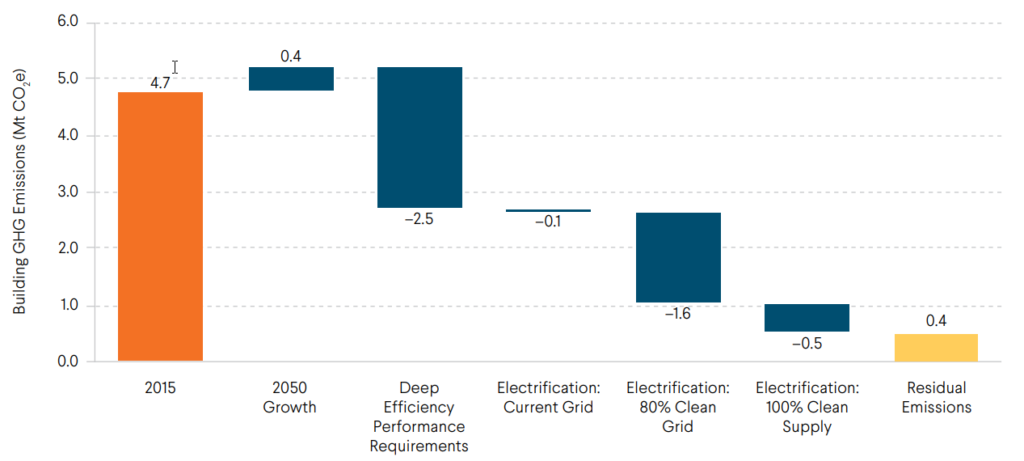This blog was originally posted by E4TheFuture on August 28, 2019.
Written by Andrew Chase, Policy Associate at E4TheFuture.
Across the United States, local and state governments have committed to reducing carbon emissions and increasing renewable generation. One significant source of emissions is our built environment — residential, commercial and industrial buildings. New York, our nation’s largest city, recently recognized that buildings comprise 70% of its total emissions. The city recently passed the Climate Mobilization Act requiring large buildings to reduce emissions by 40% by 2030–and 80% by 2050.
Minneapolis and Montpelier: Energy Labeling
Local governments can consider strategies to encourage more efficient homes. Landlords and home sellers can be required to provide incoming tenants/buyers with the building’s relative efficiency rating. This practice — gaining traction from Portland, Oregon to Montpelier, Vermont — informs tenants and buyers about their prospective energy costs.
Minneapolis recently passed an ordinance requiring the disclosure of the average cost of energy per square foot, a policy recommended in the city’s Climate Action Plan. This disclosure is intended to incentivize sellers and landlords to improve the energy performance of their buildings as they compete for buyers and tenants.
A prospective buyer looking at $1.00 in energy costs per square foot versus $2.50 can expand their list of “pro” features beyond great closet space or a recent kitchen remodel. A tenant looking at $1.50 in energy costs per square foot versus $0.80 becomes empowered to add to their “con” list and perhaps look elsewhere.
While this policy may seem like a burden on the seller or landlord, a higher-performing building will increase overall property value and make their listing more competitive. Minneapolis also provides owners low-cost visits from a “Home Energy Squad” to assess and install efficiency upgrades in their buildings, with the city providing zero-interest financing.
A recent report/assessment provided policy recommendations to help the city train new workers and increase collaboration across stakeholders to facilitate the workforce development needed to achieve climate goals (National Association of State Energy Officials, Energy Futures Initiative, BW Research Partnership). While focused on just Minneapolis, many of the recommendations are transferable to other jurisdictions with similar climate, equity and economic policies.
Montpelier, Vermont is also moving forward with required energy efficiency disclosures at the time of sale/rental. In March 2019 residents approved the ordinance in a narrow vote, 986-928. While environmentalists and the city’s mayor pushed for its passage, realtors and property owners expressed concern about the cost of compliance. The city is currently exploring details related to the implementation and enforcement of the ordinance. While Montpelier is a small city of less than 10,000 people, their action has inspired legislation, being considered by the state legislature, to require a similar labeling structure statewide.
Boston, Massachusetts: Depth and Breadth of Work Scope for Old Buildings
The city of Boston is home to 86,000 buildings, with many built prior to the existence of energy codes. In its Carbon Free Boston Summary Report (2019), Boston experts found that over two-thirds of its emissions are from buildings. Boston recognizes that efficiency is the key to reducing emissions from this sector. Deep efficiency performance requirements are the largest driver to lower building emissions, with electrification of heating and cooling comprising the rest of the reductions (assuming a cleaner grid mix).
The report estimates the cost of implementing deep efficiency based on current available technology. The graph below shows that most recommended measures to reduce a building’s energy use are projected to save money over twenty years, with lighting efficiency accounting for the quickest return on investment. In addition to the monetary benefits, the report acknowledges co-benefits including reduced air pollution, healthier indoor air quality, reduced energy burden for low-income citizens, increased resilience to climate change, job growth and increased property values.
While the Carbon Free Boston report acknowledges that the level of retrofits needed in the city to meet emissions goals would be significant (roughly 3,000 per year), it doesn’t offer a specific number of workers required or funds needed to overhaul almost every city building.
Seattle, Washington: Is $3.5B Too Much to Spend?
Researchers estimated that it would take $3.5 billion to weatherize half the homes in Seattle and electrify the majority of buildings. This amount was put in perspective, with authors noting the price is 20% less than a large transportation tunnel in Seattle. To complete the needed efficiency work, the researchers estimated it would take “…skilled work crews servicing 18,000 homes a year. That’s 346 homes a week, 70 homes a day, every year, for the next decade. Annually those crews will change out 8,000 gas furnaces and water heaters, insulate 10,000 attics, and replace tens of thousands of windows.” As in Boston, meeting ambitious carbon goals will require thousands of skilled workers supported by local businesses, governments, communities and educational institutions.
Efficiency: A Solution With Many Co-benefits
I am encouraged to see cities and states recognize the significant emissions-reducing potential of improving the efficiency of our building stock. These efficiency improvements will help address climate change and will employ thousands of local workers to implement these investments which often pay for themselves over the life cycle of the measures.
E4TheFuture is excited to highlight the continuously growing energy efficiency workforce with the release of the 2019 Energy Efficiency Jobs in America report in mid-September. The updated document provides a national summary and an overview of the energy efficiency industry, followed by details for each state. I hope that with the increased commitments in energy efficiency by cities and states our industry will continue to grow at a robust rate.


